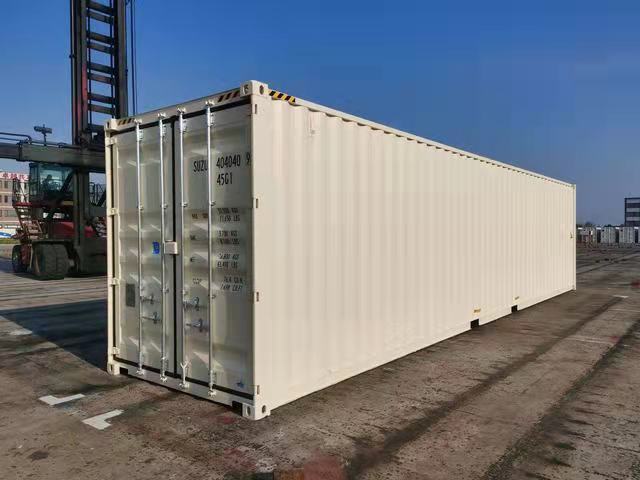The Ultimate Overview to Choosing the Right Delivery Container for Your Requirements
When it comes to picking the right delivery container, understanding your certain requirements is essential. You'll wish to consider aspects like dimension, kind, and material to assure you make the best option. From standard dimensions to specialized choices, there's a lot to explore. And also, budgeting for both the container and any kind of modifications can make a large difference. Let's damage down the vital aspects to assist you find the ideal suitable for your needs.
Recognizing Shipping Container Sizes
When you're picking a delivery container, comprehending the different dimensions available is critical for making the appropriate decision. Delivering containers typically are available in basic sizes of 20 and 40 feet, however you'll additionally locate other dimensions. Recognizing the dimension you require depends on what you intend to store or transport.If you're relocating smaller sized things, a 20-foot container may be optimal, while bigger deliveries often call for a 40-foot container. The height can likewise differ; high dice containers supply added vertical area, which can be helpful for taller goods.Before deciding, measure your freight, and take into consideration how much area you'll need for packing and unloading. Constantly aspect in possible future demands-- selecting a somewhat larger container might conserve you problem down the line. Ultimately, choosing the best dimension will certainly improve performance and ensure your products are safe and secure during transit
Kinds Of Delivery Containers Available
There are several kinds of shipping containers readily available, each made for particular objectives and cargo demands. The common dry container is functional, ideal for general freight. If you're shipping subject to spoiling products, take into consideration a chilled container, which preserves a controlled temperature. For extra-large items, high dice containers offer extra elevation, fitting taller loads.If you need to transfer heavy machinery or tools, flat rack containers supply a durable base without wall surfaces. At the same time, open-top containers enable very easy loading of high cargo, with a removable tarpaulin covering for security. If you're seeking versatility, take into consideration a collapsible container that can be easily kept when not in use.Lastly, specialized containers like tank containers are made use of for liquids, while vented containers are made for bulk freight that requires ventilation. Recognizing your freight kind will certainly help you select the appropriate container to satisfy your delivery needs successfully.
Material Factors To Consider for Longevity
When choosing a shipping container, the material plays a crucial role in its resilience. You'll want to evaluate the benefits of steel versus light weight aluminum, specifically pertaining to deterioration resistance. Comprehending these variables can aid you make a more educated choice for your delivery needs.
Steel vs. Light weight aluminum Containers
How do you pick in between steel and light weight aluminum containers for your delivery requires? Beginning by taking into consideration durability. Steel containers are durable and deal excellent toughness, making them optimal for heavy lots and extreme conditions. They withstand damage from impacts and are commonly cheaper, which can be a major element for budget-conscious buyers.On the other hand, aluminum containers are lightweight, which can save you on delivery costs. They're easier to maneuver and are a terrific option if you require to transport products frequently. Nonetheless, light weight aluminum is normally more expensive and much less durable than steel. Weigh your particular needs very carefully, including weight, cost, and the sort of freight you'll be shipping, to make the appropriate choice for your circumstance.
Rust Resistance Factors
Picking the appropriate material doesn't simply include weight and price; deterioration resistance plays a considerable role in toughness. When selecting a shipping container, think about the atmosphere it'll deal with. Steel containers, while solid, can rust otherwise appropriately dealt with. Search for alternatives with protective layers or galvanization to boost their life-span. Light weight aluminum, on the other hand, supplies all-natural rust resistance, making it ideal for seaside areas or moist problems. It can be much more costly. Furthermore, examine the container's usage-- if it'll be subjected to chemicals or severe climate, prioritize materials that can hold up against these problems. Buying a corrosion-resistant container currently can conserve you from expensive repair work or substitutes down the line. Pick wisely for long-term benefits.
Adjustments and Personalization Options
Delivering containers aren't simply for carrying items; they can be transformed to meet your specific demands through various alterations and modification alternatives. You can transform a common container right into a comfortable office space, a short-lived retail store, and even an individual gym. The possibilities are virtually endless.Think about adding home windows, insulation, or ventilation to boost convenience. You could additionally think about electric circuitry, pipes, and even custom shelving to site link boost performance. If protection's a worry, enhanced locks can supply tranquility of mind.For aesthetic charm, you can repaint the container or add an unique design to make it attract attention. Do not forget regarding floor covering alternatives-- whether you want sturdy plywood or something much more innovative, it can raise the space.Ultimately, tailoring your delivery container to suit your requirements can boost functionality and produce a distinct setting that shows your design.
Analyzing Your Transportation Demands
When it concerns utilizing your changed shipping container, recognizing your transport needs is crucial. Start by identifying what you'll be delivery-- whether it's heavy devices, retail products, or individual items. Each type of freight has different demands relating to size, weight, and accessibility.Next, take into consideration the range and setting of transportation. Are you delivering locally, nationally, or globally? This influences the container's design and capability. If you're making use of vehicles, guarantee your container fits standard dimensions for very easy loading and unloading.Additionally, think regarding transit conditions. Will your products need special defense from climate or temperature level fluctuations? If so, you might require insulation or ventilation features in your container.Lastly, evaluate how usually you'll be carrying goods. Constant deliveries may need a more resilient and functional container to satisfy continuous needs. By resolving these factors, Visit This Link you'll be well-prepared to select the appropriate delivery container for your requirements.
Budgeting for Your Delivery Container
Setting an allocate your shipping container is necessary for guaranteeing a smooth purchasing process. First, determine just how much you can pay for to invest. Rates can differ considerably based on dimension, problem, and kind. New containers usually set you back more, but used ones can offer substantial savings.Next, visite site consider any extra costs you may incur, such as transportation costs, delivery fees, and alterations. If you plan to tailor the container, consider those costs too. Research study various vendors to contrast rates and find the very best offer that satisfies your needs.Don' t forget to include any kind of permits or guidelines that may apply to your acquisition and use the container. By plainly outlining your budget, you'll be much better prepared to make enlightened decisions, ensuring you get the ideal container without damaging the financial institution.
Maintenance and Take Care Of Longevity
To guarantee your shipping container lasts for many years, regular maintenance is key. Begin by evaluating the outside for corrosion, damages, and damage. If you detect any type of issues, address them promptly to protect against more degeneration. Clean the container regularly, both within and out, to remove dirt, particles, and moisture that can cause corrosion.Ensure the doors secure properly and oil the hinges to avoid rust and sticking. If you're utilizing the container for storage space, think about including air flow to decrease humidity and mold and mildew growth. For extra defense, apply a rust-inhibiting paint or sealant annually.If your container's located in an extreme atmosphere, like seaside areas, you may need to boost maintenance frequency. Watch on the floor covering, too; any kind of indications of wear need to be repaired as soon as possible. With these straightforward actions, you'll expand the life of your delivery container substantially.
Frequently Asked Questions
Exactly how Do I Discover a Trustworthy Shipping Container Vendor?
To discover a trustworthy shipping container distributor, start by researching online testimonials, requesting referrals from close friends or sector get in touches with, and contrasting prices. Always inspect their credentials and warranty they supply high quality containers that satisfy your demands.

Can I Lease a Delivery Container As Opposed To Purchasing?
Yes, you can certainly rent a delivery container as opposed to acquiring one. Lots of distributors offer rental options, which can conserve you money and supply versatility if you just require it for a brief duration.
What Permits Are Needed for Container Positioning?

Are Shipping Containers Weatherproof and Appropriate for Outdoor Storage Space?
Yes, shipping containers are normally weatherproof, made to withstand harsh problems. Their durable building maintains your products protected and dry, making them appropriate for outside storage. Simply ensure proper air flow to stop wetness buildup inside.
Exactly how Do I Transfer a Shipping Container Once Acquired?

 Tatyana Ali Then & Now!
Tatyana Ali Then & Now! Alisan Porter Then & Now!
Alisan Porter Then & Now! Marques Houston Then & Now!
Marques Houston Then & Now! Elin Nordegren Then & Now!
Elin Nordegren Then & Now! Brooke Shields Then & Now!
Brooke Shields Then & Now!